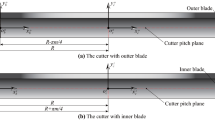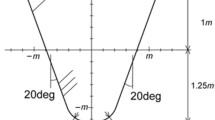Abstract
In validating a computational model to evaluate the efficiency of a cylindrical gear, the friction work in the tooth contact is expressed through the total sliding distance along the length of the involute of the tooth. This allows one to determine the dependence of the efficiency of the gear uon the value of the torque passed to it.
Similar content being viewed by others
References
Pavlov, V.G. and Yagovitov, V.D., Probl. Mashinostr. Nadezhnosti Mash., 2009, no. 4, p. 50.
Reshetov, D.N., Detali mashin, (Machine Elements), Moscow: Mashinostroenie, 1989.
Detali mashin. Raschet i konstruirovanie. Spravochnik. T. 3, (Machine Elements. Calculation and Designing. Handbook. Vol. 3), Acherkan, N.S., Ed., Moscow: Mashinostroenie, 1969.
Chasovnikov, L.D., Peredachi zatsepleniem (Gearings by Engagement), Moscow: Mashinostroenie, 1969.
Author information
Authors and Affiliations
Additional information
Original Russian Text © V.G. Pavlov, 2010, published in Problemy Mashinostroeniya i Nadezhnosti Mashin, 2010, No. 4, pp. 81–85.
About this article
Cite this article
Pavlov, V.G. Effect of contact-kinematical slippage in toothing on deterioration and efficiency of cylindrical involute gears. J. Mach. Manuf. Reliab. 39, 371–374 (2010). https://doi.org/10.3103/S1052618810040114
Received:
Published:
Issue Date:
DOI: https://doi.org/10.3103/S1052618810040114




